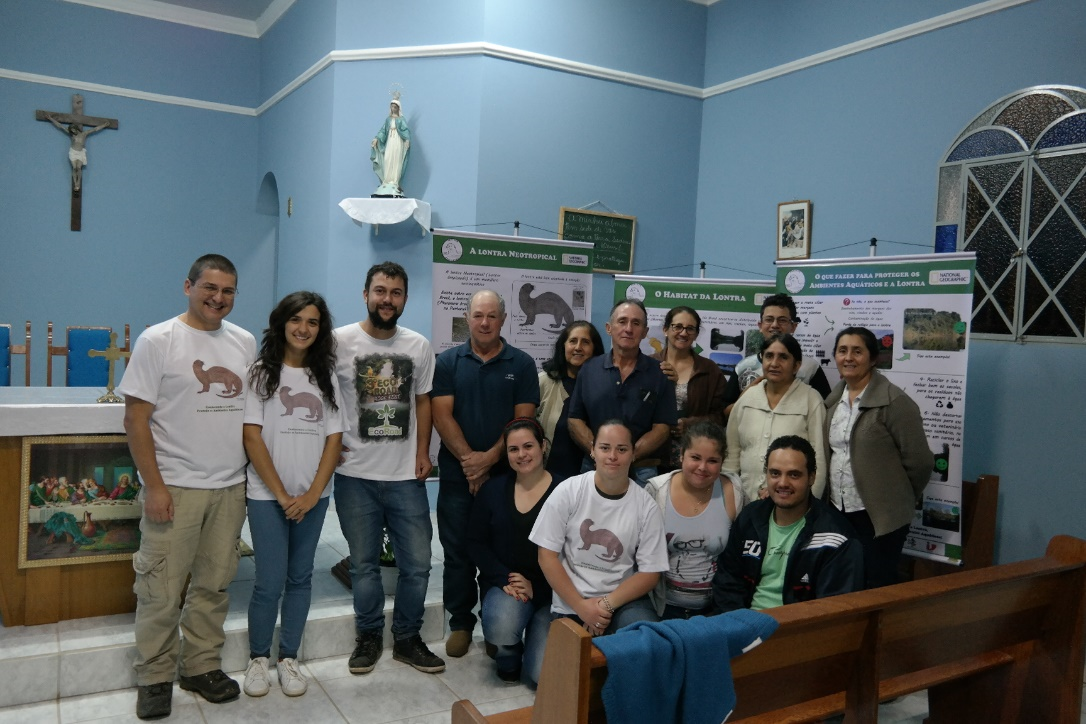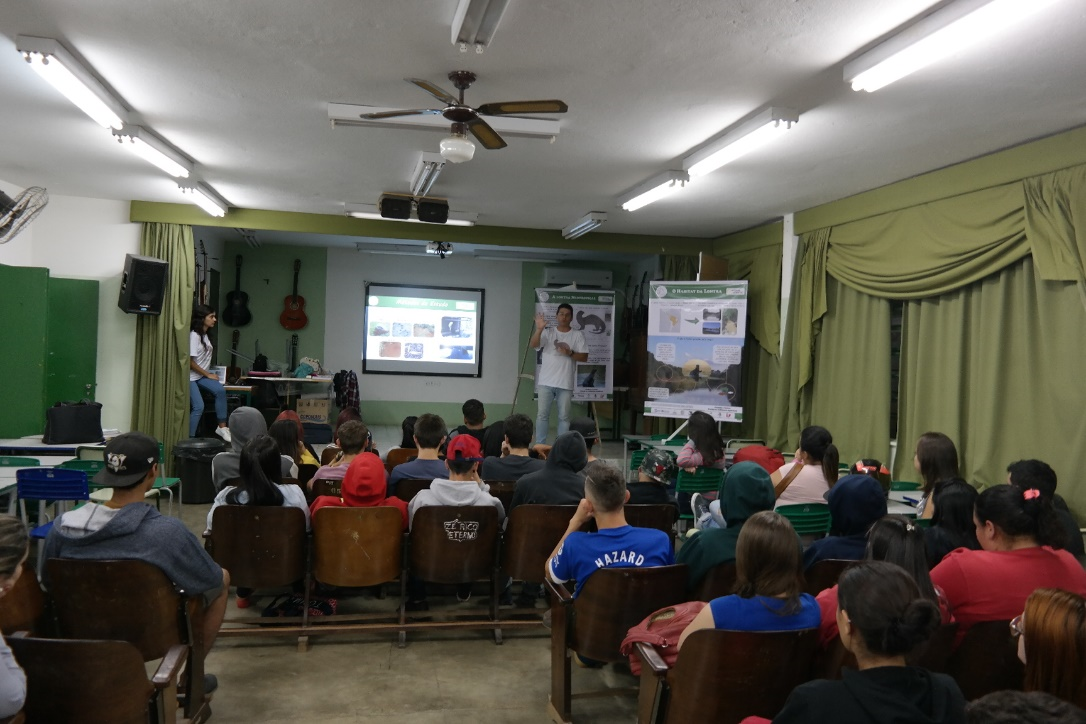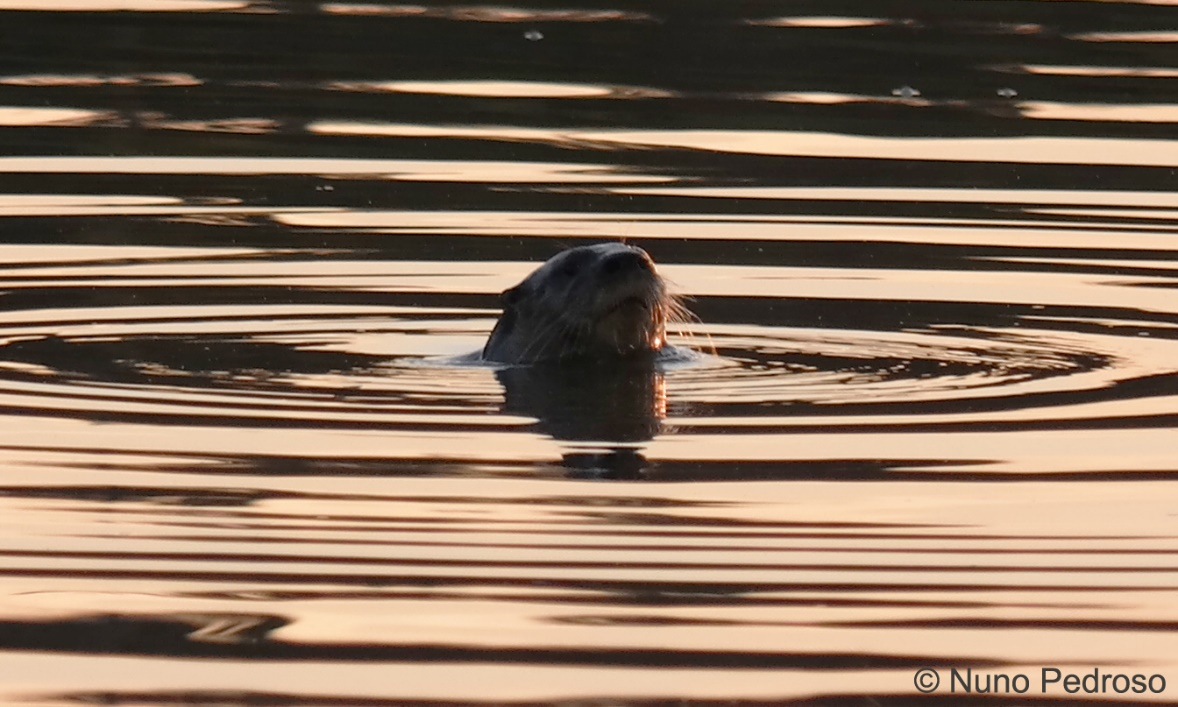IUCN/SSC Otter Specialist Group Bulletin

©IUCN/SCC Otter Specialist Group
Volume 36 Issue 1 (January 2019)
Citation: Dias, SV, Verdade, LM, Prado, B, Zanetti, V, Almeida, N, Santos-Reis, M and Pedroso, NM (2019). Neotropical Otters as Promoters of Environmental Awareness . IUCN Otter Spec. Group Bull. 36 (1): 17 - 27
Neotropical Otters as Promoters of Environmental Awareness
Sofia V. Dias1, Luciano M. Verdade2, Bárbara Prado3, Victor Zanetti4,5, Nain Almeida5, Margarida Santos-Reis1 and Nuno M. Pedroso1, 2
1 cE3c – Centre for Ecology, Evolution and Environmental Changes, Faculty of Sciences, University of Lisbon. Ed. C2, Campo Grande, 1749-016 Lisbon, Portugal. e-mail: ana.sofia.dias@campus.ul.pt
2 CENA – University of São Paulo, Piracicaba, SP, Brazil.
3 São Paulo Forestry Institute – Angatuba Ecological Station, Angatuba, SP, Brazil
4 Orestes Oris de Albuquerque and Ivens Vieira State Schools, Angatuba, SP, Brazil
5 NGO Ecoroad, Angatuba, SP, Brazil
Received 10th February 2018, accepted 30th December 2018
Abstract: Otter species can be used as flagship to promote the protection of aquatic environments in regions where they are known or regularly seen. In a previous study on the perceptions of local communities about the Neotropical otter (Lontra longicaudis) in Central-South São Paulo State, Brazil, we identified knowledge gaps and population groups with potential for conflict with the species. We also assessed the species local distribution and found that habitat quality was deteriorating, due to aquatic contamination by urban waste and antibiotics and destruction of the riparian vegetation. To tackle this situation, with financial support from the National Geographic Society, we designed and implemented an awareness campaign having the Neotropical otter as a flagship species (“Projeto Neolontra“). The project goals were to: i) raise awareness on aquatic species and habitats valuing the previews information given by the population; ii) prevent the intensification of human-otter conflicts; and, additionally, iii) complete the assessment of otter distribution in the region, building on local knowledge and field campaigns. For that we conducted 27 talks to 1337 attendees between August and October 2017 and produced awareness materials (posters, t-shirts, handouts), informally delivering science-based information to local populations. With this project we were able to link societal challenges, biodiversity conservation principles, and education actions, involving local partners and institutions, contributing to empower their role within the community and influencing decision makers on issues such as water use, riparian habitats preservation, urban waste effects, and medications disposal needs
Keywords: awareness campaigns, local knowledge, Lontra longicaudis, Projeto Neolontra, Brazil, aquatic environments
The knowledge on resource use and practices by local populations can be an important input for scientific or educational studies (Crepaldi and Peixoto, 2010). Their active involvement in these studies can help researchers and conservation practitioners to adapt conservation programs to benefit both biodiversity and local communities (Conway et al., 2015).
The participation of local communities in conservation actions has become increasingly important over the years (Borrini-Feyerabend, 1997). Environmental education actions are growing, seeking development of critical thinkers with knowledge, skills and attitudes necessary for long-term responsible behaviours towards biodiversity (Short, 2010). In most cases, educational actions are species or taxa-specific, these being used as symbols or “flagship”, to stimulate conservation awareness and actions from selected audiences (Bowen-Jones and Entwistle, 2002). Generally, those flagship species are charismatic and benefit from international recognition - e.g., the lion (Panthera leo) or the giant panda (Ailuropoda melanoleuca) but may not be perceived as such at a local scale. This is the case of species that have a restricted distribution/abundance, are inconspicuous or negatively affect local communities (e.g. destruction of crops, competition for resources) (Bowen-Jones and Entwistle, 2002; Stevens et al., 2011). In such cases, the use of a species, locally perceived as important, is recommended for the effectiveness of conservation efforts (Bowen-Jones and Entwistle, 2002).
Otters are semi-aquatic mammals, occurring in a wide variety of water bodies such as rivers, lakes, streams, coastal areas or even in the open sea (Kruuk, 2006). They are strictly dependent of aquatic environments, especially because of their diet (composed mainly by fish and crustaceans) (Kruuk, 2006).
Due to the importance of water as an essential resource to mankind, otters, in areas where they are well known or regularly seen, can be used as a flagship species to promote the protection of aquatic environments, as they usually generate positive reactions from people (e.g. Bright and Morris, 2000; Bath and Farmer 2002), being considered playful, cute and attractive animals (Chanin, 1985; Cohn, 1998; Kruuk, 2006). However, in areas where fishing or fish farming activities are significant, and otters are abundant, public opinion diverges due to predation upon fish and shellfish species (Freitas et al., 2007; Václavíková et al., 2011). Differences in perception between regions or population groups, indicate that the assessment of otter species as a proper flagship species is a necessary step before the implantation of environmental or awareness actions (e.g. Norris and Michalski, 2009).
The use of otters as flagship species can be exemplified in different parts of the world. In Peru, Schenck et al. (1999) and Groenendijk and Hajek (2004) reported on the use of the giant otter (Pteronura brasiliensis) as a flagship species to highlight importance of water bodies, also using educational material (e.g. posters, handouts and educational slide packs). In Europe, the Eurasian otter (Lutra lutra) is extensively used as a flagship species (Bifolchi and Lodé, 2005; Kruuk, 2006; Stevens et al., 2011) and many biodiversity action plans include the use of otters as flagship species to promote protection of aquatic environments (Stevens et al., 2011).
In a previous study, conducted during 2015 and 2016 in the São Paulo State, Brazil (Dias 2016), we focused on the Neotropical otter, Lontra longicaudis, considered “Near Threatened”, both by the International Union for Conservation of Nature (IUCN) (Rheingantz and Trinca, 2015) and the Brazilian government (Rodrigues et al., 2013). The São Paulo State is the most densely populated and developed state of Brazil, where ecosystems face serious pressures such as deforestation, water pollution and riverine vegetation degradation (Lyra-Jorge et al., 2008). We collected information about the species combining interviews to locals (mostly fishermen and small pond users) and field surveys (foot or boat transects for otter sign detection in rivers, streams and ponds). Besides evaluating the knowledge on and attitudes towards the otter, interviews provided us complementary and opportunistic information on the species distribution and revealed anthropic threats for the aquatic environments. Local communities described several interactions with the Neotropical otter (e.g., direct observations of individuals, including predation of fish in nets), and revealed knowledge on the species habits, but also misconceptions such as the amount of fish consumed by individual otters or its protection status. A potential conflict emerged with fishermen and small pond users, since these are stocked with fish and act as attraction points for otters. We also identified local threats to the species, namely aquatic contamination by urban waste and riparian degradation (Dias, 2016). Additionally, we proved the presence of antimicrobial resistant bacteria in otter faeces, resulting from aquatic contamination by local cattle and poultry (Semedo-Lemsaddek et al., 2018).
The need of changing attitudes towards the otter and the aquatic environments motivated us to write a project proposal (“Projeto Neolontra – Otter in human-altered environments: changing attitudes”), submitted for funding to National Geographic Society - Early Career Grants, with three main aims: raise awareness on aquatic species and habitats, valuing the information previously given by the population; prevent the intensification of human-otter conflicts; and complete the assessment of otter distribution in the region. This project was developed with the communities of the same geographical area of the previous study (Dias, 2016).
METHODS
Projeto Neolontra, conducted between August and October 2017, focused on awareness and educational actions, to promote the conservation of the Neotropical otter and its habitat in Angatuba, Guareí and Campina do Monte Alegre municipalities (São Paulo, Brazil) (Fig. 1).
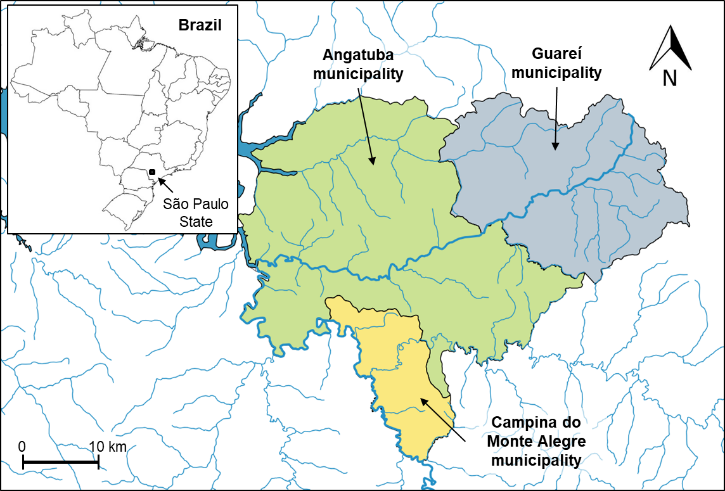
The approach followed consisted of a series of talks to a diverse audience and population sectors of the local communities (e.g. fishermen and small pond users). Detailed information was provided about the Neotropical otter, targeting in particular the previously identified misconceptions about the species (e.g. that the otter is not a protected species and that it consumes around 4-6kg of fish per day, when in fact consumes about 10% of its body-weight (Kruuk, 2006) (otters weigh between 7kg to 14kg – Almeida and Pereira, 2017). We disseminated scientific information about aquatic species and habitats that most of the local population do not have access (e.g. importance of water quality, consequences of deforestation caused by agriculture, and effects of antibiotics diffusion in the aquatic systems) and promoted good practices related to waste management, aquatic and riparian preservation, and management of small ponds.
The talks were organized in the main locations where previous interviews were conducted, but also in schools and local universities (Table 1).
Stakeholders meetings were conducted with the support of Angatuba Ecological Station (henceforth EEcA, based on the Portuguese acronym of “Estação Ecológica de Angatuba”), with the presence of representatives of local governments.
Each of our educational actions were adapted to the specific audience (Table 1), including showing maps of otter presence in the area and nearby focus of aquatic contamination, which resulted from their contribution to our research (data obtained during previous interviews) plus results from our field campaigns.
In addition, we produced posters, handouts about the Neotropical otter and aquatic environments, and otter t-shirts (Fig. 2), to be freely distributed in the end of the talks.
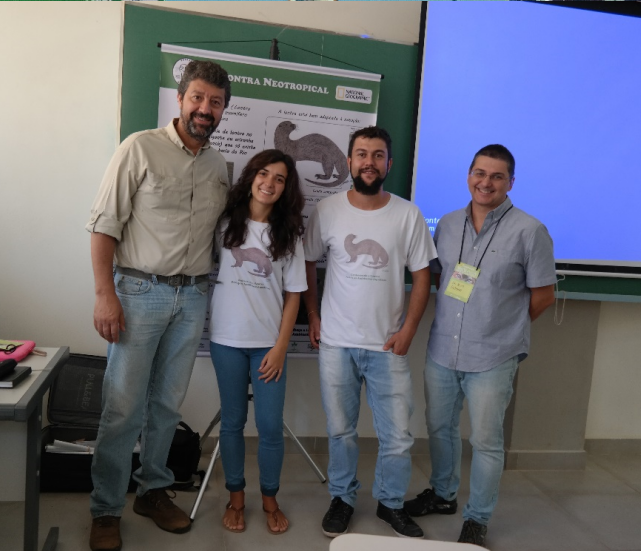
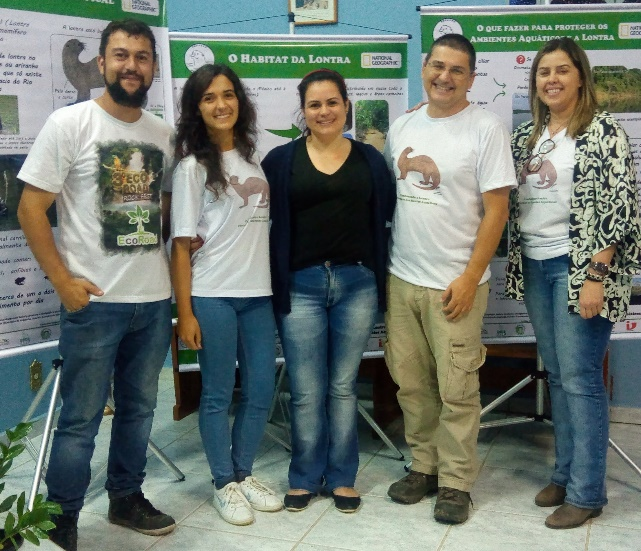
Top: left to right: Luciano M. Verdade, Sofia V. Dias, Victor Zanetti and Nuno M. Pedroso
Bottom: left to right: Victor Zanetti, Sofia V. Dias, Attendee of the lecture, Nuno M. Pedroso and Bárbara Prado
Three informative banners were also designed for graphical support in our talks (acting as source of information for the attendees during and after the talk) and outdoor events (acting as a way to attract the public and encourage some further questions about the otter) (Fig. 3).
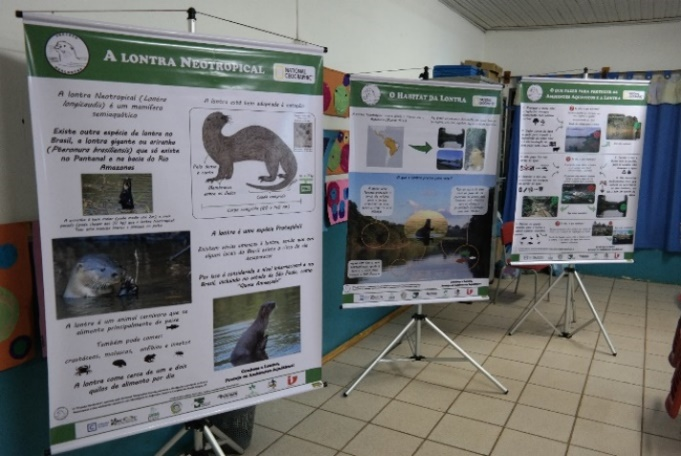
The distributed handouts indicated a list of actions to mitigate further water contamination and pollution, riparian degradation and encourage the recycling of urban waste and the collection of medications and drugs that are no longer used by the population.
In small villages with high prevalence of fishing activities, we also addressed strategies for fishing net placement to avoid otter predation and to prevent the development of conflicts with the otter.
To determine how many attendees had incorrect knowledge about the otter ecology, we conducted a survey about the amount of food ingested per day and the protection status of the species during our lectures. Additionally, we collected additional otter sightings among the attendees of our events and used that information to address new field campaigns in the region to search for otter signs of presence (spraints, burrows, claw marks, footprints) and complement our previous otter distribution data.
A Facebook page was created (https://www.facebook.com/ProjetoNeolontra/), where we posted information about the Neotropical otter, the support material for the talks, dates of events and new records of the species in the area collected by inhabitants.
All the produced education materials and presentations (including their digital versions) were provided to our local partners to be used in future environmental actions and events.
RESULTS
A total of 27 talks were conducted, involving 1337 attendees, a number almost doubling the predicted in the project proposal (Fig. 4 and 5). This result was a consequence of several invitations from teachers, public and private schools and neighbourhood communities along the project implementation. This unexpected attendance also led to the necessity of increasing the number of handouts (1500 instead of 1000 predicted in the project proposal) and t-shirts (120 instead of 100) produced.
In each event, attendees also provide us information about specific areas were the riparian vegetation is decreasing and new threat factors such as the appearance of non-native species of fish that are competing with native ones, unbalancing fish communities.
Regarding the percentage of attendees with incorrect knowledge of the species ecology, in all our lectures at least 50% of the audiences thought that the otter was an important species, but not legally protected and that it ingests up to 6 kg of food per day. Both these aspects are not correct as previously mentioned.
From our field surveys conducted on the basis of otter sightings referred to by the attendees of our events, we were able to confirm 12 (11%) new otter locations (Fig. 6). In two of these we had the opportunity to spot, photograph and film the species (Fig. 7), material used in the following events.
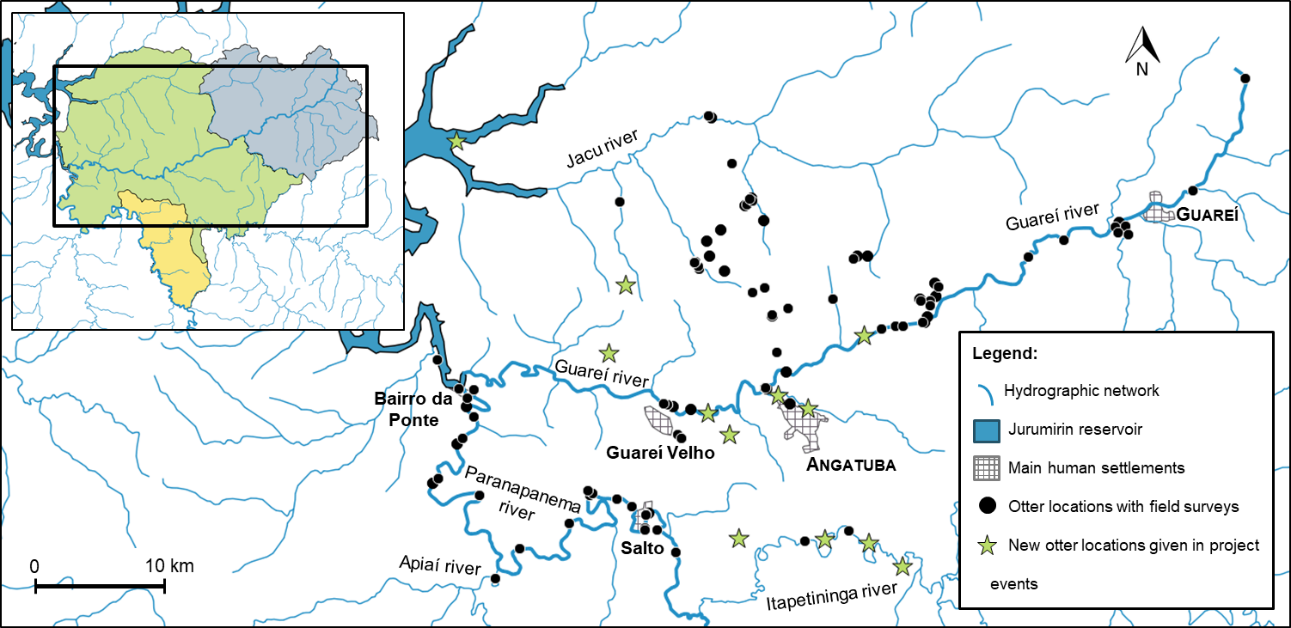
Besides talks, six meetings were promoted with stakeholders and local decision makers including mayors, city councilmen and Federal deputies. In the course of these, they were informed about the environmental concerns identified during the course of our work and discussions followed on possible future actions to diminish environmental degradation in the region. Occurrence of antimicrobial resistance in aquatic environments is an important concern of public health, since aquatic environments are used by local inhabitants in their daily tasks (e.g. fishing, transport, leisure, urban use). Several stakeholders and representatives of local governments became especially interested in this matter as they have been informed about how the use of not only antibiotics, but also insecticides and fertilizers may affect aquatic environments and human health by excessive use, runoff from facilities and cattle defecation in rivers. Interest was also shown on further discussions on how to implement an after-use medication collecting system to mitigate further contamination.
DISCUSSION
This project illustrates how a targeted science-based awareness campaign, involving multiple actions and stakeholders can contribute for the promotion of aquatic environments, explaining how they are very sensitive to anthropic induced changes, but also home of important biodiversity, including the Neotropical otter.
The unexpected increase in the number of invited talks and attendees reflects the success of both using the Neotropical otter as a means for educational campaigns and of our willingness to share the research developed in the region, both welcomed by local partners and the whole community. The percentage of attendees with incorrect knowledge of the species ecology was high (50% in average), before the events, so now around 600 people have a corrected perspective, and in the overall the members of the local communities have access to scientific sound information.
The meetings with stakeholders, including the mayors of Angatuba and Guareí municipalities, city councilmen and Federal deputies from Campina do Monte Alegre and Itapetininga municipalities, resulted not only in possible future actions regarding aspects like urban waste, rational use of water, riparian preservation and medications/drugs disposal, but concretely in the inclusion of some of these issues in the local political programs.
We have contributed for the empowerment of local partners (Ecoroad - local NGO that acts on environmental awareness, teachers and Forest Institute technicians) and promoted their role among local communities, capacitating them to act independently to promote otter conservation and aquatic protection after the end of this project. Our project promoted some immediate agreements and actions from of our local partners:
- inclusion of otter and water systems conservation in school syllabus by teachers (biology classes of 7th graders and high school students);
- otter monitoring will be performed during the regular river cleaning activities of Ecoroad; and
- the educational materials produced within the project will be replicated for future awareness campaigns by local partners.
The approaches used in this project revealed to be effective for the area, given the lack of similar awareness actions and the interest demonstrated by the local population (especially students). For example, we confirmed that some students had already transmitted the information at home to their family members, spreading the information of our project and the list of good practices towards aquatic environments and species. After the end of “Projeto Neolontra” the local interest in the Neotropical otter was maintained. For instance, in Angatubas’s schools, the students painted walls dedicated to the local fauna, including an area dedicated to the otter and the aquatic environments in particular. An annual drawing contest with the otter as the central piece is also implemented. Additionally, the Neotropical otter became the mascot of the Annual Environmental Forum of Angatuba.
This project is an example on how, with limited funds (4980 USD) and time (one and a half months), it is possible to involve diverse (and sometimes antagonistic) stakeholders in an awareness campaign, contributing to the prevention of possible conflict situations with the Neotropical otter and improve the local knowledge about the species.
Acknowledgements: We would like to thank Caroline Leuchtenberger for providing the photos of the Neotropical otter and giant otter used in our educational material and to Angatuba and Guareí municipality offices for the printing of extra handouts. We acknowledge the logistic support of Angatuba Ecological Station / São Paulo Forestry Institute (EEcA/IF) and its cooperation along with Ecoroad and Orestes Oris de Albuquerque and Ivens Vieira State Schools of Angatuba in all our events. We thank Ivan Prego Alonso for the Spanish abstract. SVD was supported by an Early Career Grant from National Geographic Society (#WW-073EE-17) and NMP was supported by grant #2014/08601-6, Fundação de Amparo à Pesquisa do Estado de São Paulo (FAPESP). >LMV holds a Productivity Scholarship from Conselho Nacional de Desenvolvimento Científico e Tecnológico (CNPq, grant # 309468/2011-6).
REFERENCES
Almeida, L.R., Ramos Pereira, M.J. (2017). Ecology and biogeography of the Neotropical otter Lontra longicaudis: existing knowledge and open questions. Mamm Res. 62:313–321.
Bath, A., Farmer, L. (2000). Europe’s carnivores: A survey of children’s attitudes towards wolves, bears and otters. WWF-UK Report. Surrey.
Bifolchi, A., Lodé, T. (2005). Efficiency of conservation shortcuts: an investigation with otters as umbrella species. Biological Conservation 126:523-527
Borrini-Feyerabend, G. (1997). Beyond Fences: Seeking Social Sustainability in Conservation. IUCN, Gland.
Bowen-Jones, E., Entwistle, A. (2002). Identifying appropriate flagship species: the importance of culture and local contexts. Oryx 36:189-195.
Bright, P.W., Morris, P.A. (2000). Rare mammals, research and realpolitik: priorities for biodiversity and ecology? In: Entwistle, A., Dunstone, N. (Eds.). Priorities for the conservation of mammalian diversity: has the panda had its day? Cambridge University Press, Cambridge, UK, pp.141-155.
Chanin, P. (1985). The natural history of otters. Facts on File Publications, New York.
Cohn, J.P. (1998). Understanding sea otters: Exxon Valdez oil spill engenders research that sheds light on these cute, cuddly creatures. Bioscience 48:151-155.
Conway, A.L., Hernandez, S.M., Carroll, J.P., Green, G.T., Larson, L. (2015). Local awareness of and attitudes towards the pygmy hippopotamus Choeropsis liberiensis in the Moa River Island Complex, Sierra Leone. Oryx 49:550-558.
Crepaldi, M.O.S., Peixoto, A.L. (2009). Use and knowledge of plants by “Quilombolas” as subsidies for conservation efforts in an area of Atlantic Forest in Espírito Santo State, Brazil. Biodivers. Conserv. 19:37-60.
Dias, A.S.V. (2016). The Neotropical otter in southeast Brazil: a socioecological approach. Master Thesis. Faculty of Sciences, University of Lisbon, Lisbon, Portugal. (https://repositorio.ul.pt/bitstream/10451/25638/1/ulfc120619_tm_Ana_Dias.pdf).
Freitas, D., Gomes, J., Luis, T.S., Madruga, L., Marques, C., Baptista, G., Rosalino, L.M., Antunes, P., Santos, R., Santos-Reis, M. (2007). Otters and fish farms in the Sado estuary: Ecological and socio-economic basis of a conflict. Hydrobiologia 587: 51-62.
Groenendijk, J., Hajek, F. (2004). Giant Otter Project in Peru: Field Trip and Activity Report - 2003. IUCN Otter Spec. Group Bull. 21(1):40-46.
Kruuk, H. (2006). Otters: ecology, behavior, and conservation. Oxford University Press, New York.
Lyra-Jorge, M.C., Ciocheti, G., Pivello, V.R. (2008). Carnivore mammals in a fragmented landscape in northeast of São Paulo State, Brazil. Biodivers. Conserv. 17:1573-1580.
Norris, D., Michalski, F. (2009). Are Otters an Effective Flagship for the Conservation of Riparian Corridors in an Amazon Deforestation Frontier? IUCN Otter Spec. Group Bull. 26(2):73-77.
Rheingantz, M.L., Trinca, C.S. (2015). Lontra longicaudis. IUCN Red List Threatened Species 2017-3. http://dx.doi.org/10.2305/IUCN.UK.2015-2.RLTS.T12304A21937379.en. Last accessed 15 Dec 2017.
Rodrigues, L.D.A., Leuchtenberger, C., Kasper, C.B., Carvalho-Junior, O., Silva, V.C.F. (2013). Avaliação do risco de extinção da Lontra neotropical. Biodivers. Bras. 3:216-227.
Schenck, C., Groenendijk, J., Hajek, F. (1999). Giant Otter Project in Peru: Field Trip and Activity Report - 1998. IUCN Otter Spec. Group Bull. 16(1):33-43.
Semedo-Lemsaddek, T., Pedroso, N.M., Freire, D., Nunes, T., Tavares, L., Verdade, L.M. Oliveira, M. (2018) Otter fecal enterococci as general indicators of antimicrobial resistance dissemination in aquatic environments. Ecol. Indic. 85:1113-1120.
Short, P. C. (2010). Responsible Environmental Action: Its Role and Status in Environmental Education and Environmental Quality. J. Environ. Educ. 41:7-21.
Stevens, S.S., Organ, J.F., Serfass, T.L. (2011). Otters as Flagships: Social and Cultural Considerations. IUCN Otter Spec. Group Bull. 28(A):150-161.
Václavíková, M., Václavík, T., Kostkan, V. (2011). Otters vs. fishermen: Stakeholders’ perceptions of otter predation and damage compensation in the Czech Republic. J. Nat. Conserv. 19:95-102.
Résumé : Les Loutres à Longue Queue, des Promoteurs de la Sensibilisation à l’Environnement
Les espèces de loutres peuvent être utilisées comme espèce parapluie pour promouvoir la protection des milieux aquatiques dans les régions où elles sont connues ou régulièrement observées. Dans une étude précédente, sur les perceptions des communautés locales à propos de la loutre à longue queue (Lontra longicaudis) dans le centre-sud de l'État de Sao Paulo au Brésil, nous avons identifié des lacunes dans les connaissances et des groupes de population en conflit potentiel avec l'espèce. Nous avons également évalué la distribution locale de l'espèce et constaté que la qualité de l'habitat se détériorait en raison de la contamination des milieux aquatiques par les déchets urbains et les antibiotiques, et la destruction de la végétation rivulaire. Pour faire face à cette situation, avec le soutien financier de la National Geographic Society, nous avons conçu et mis en œuvre une campagne de sensibilisation faisant de la loutre à longue queue une espèce parapluie («Projeto Neolontra»). Les objectifs du projet étaient les suivants: 1) sensibiliser le public aux espèces et habitats aquatiques en valorisant les informations fournies par la population; 2) prévenir l'intensification des conflits entre l’homme et la loutre ; et, de plus, 3) compléter l’évaluation de la répartition de la loutre dans la région, en s’appuyant sur les connaissances locales et les campagnes sur le terrain. Pour cela, nous avons mené 27 entretiens devant 1.337 participants entre août et octobre 2017. Nous avons conçu du matériel de sensibilisation (affiches, t-shirts, documents distribués) et avons fourni de manière informelle des informations scientifiques aux populations locales. Grâce à ce projet, nous avons pu connecter les défis sociétaux, les principes de conservation de la biodiversité et les actions d’éducation, impliquant les partenaires locaux et les institutions, contribuant à renforcer leur rôle au sein de la communauté et influençant les décideurs face à des problèmes tels que la consommation d’eau, la préservation des habitats rivulaires, l’impact des déchets urbains et la nécessité d’éliminer les médicaments.
Revenez au dessus
Resumen: Nutrias Neotropicales como Promotores de Conciencia Ambiental
Las especies de nutrias pueden ser utilizadas como especies bandera para promover la protección de ambientes acuáticos en regiones donde se les conoce o ve regularmente. En un estudio previo sobre las percepciones de las comunidades locales sobre la nutria neotropical (Lontra longicaudis) en el centro-sur del estado de São Paulo (Brasil) identificamos lagunas de conocimiento y grupos de población con potencial conflicto con la especie. Evaluamos también su distribución local, y encontramos que la calidad del hábitat se estaba deteriorando debido a la contaminación acuática (desechos urbanos, antibióticos) y destrucción de vegetación riparia. Para hacer frente a esta situación, con financiación de National Geographic Society, diseñamos e implementamos una campaña de sensibilización con la nutria neotropical como especie bandera ("Projeto Neolontra"). Los objetivos fueron: i) crear conciencia sobre especies y hábitats acuáticos, valorando la información previamente proporcionada por la población; ii) prevenir la intensificación de conflictos hombre-nutria; y, adicionalmente, iii) completar la evaluación de la distribución de nutrias en la región, aprovechando conocimiento local y campañas de campo. Para eso, realizamos 27 charlas con 1337 asistentes, entre Agosto y Octubre de 2017, y produjimos materiales de concienciación (carteles, camisetas, folletos), entregando informalmente información con base científica a las poblaciones locales. Con este proyecto fuimos capaces de establecer vínculos entre desafíos sociales, principios de conservación de biodiversidad y acciones educativas, involucrando a interlocutores e instituciones locales, contribuyendo así a empoderar su rol en la comunidad e influenciando a los tomadores de decisiones en temas como usos del agua, preservación de hábitats ribereños, efectos de los desechos urbanos y necesidades para la disposición final de medicamentos.
Vuelva a la tapa
Resumo: A Lontra Neotropical como Promotora de Melhoria Ambiental
As lontras podem ser usadas como espécies-bandeira para a proteção de ambientes aquáticos em regiões onde sejam conhecidas ou regularmente vistas. Num estudo anterior sobre as perceções de populações locais do Centro-Sul do Estado de São Paulo sobre a lontra Neotropical (Lontra longicaudis), identificamos lacunas de conhecimento e grupos populacionais com potencial para o conflito com a espécie. Avaliamos igualmente a distribuição local da espécie e verificámos que a qualidade do habitat está a deteriorar-se, devido à contaminação aquática por resíduos urbanos e antibióticos e à destruição da vegetação ripária. Face a esta situação, com o apoio financeiro da National Geographic Society, idealizamos e implementámos um projeto de consciencialização com a lontra Neotropical como espécie-bandeira ("Projeto Neolontra"). Os objetivos deste projeto foram: i) aumentar o conhecimento sobre a espécie e habitats aquáticos, valorizando as informações previamente fornecidas pela população local; ii) prevenir conflitos entre as populações humanas e a lontra; e, iii) completar a avaliação da distribuição da lontra na região, com base em informação local e campanhas de campo. Para tal, efetuamos 27 palestras para 1337 participantes e produzimos materiais educativos (posters, t-shirts, folhetos), fornecendo informação científica simplificada às populações locais. Com este projeto, foi possível aliar desafios sociais, princípios de conservação da biodiversidade e ações de educação, envolvendo parceiros e instituições locais, contribuindo para a sua capacitação na comunidade e influenciando decisores locais em questões como uso da água, preservação dos habitats ripários, efeitos de contaminação por resíduos urbanos e necessidade de recolha de medicamentos usados.
As lontras podem ser usadas como espécies-bandeira para a proteção de ambientes aquáticos em regiões onde sejam conhecidas ou regularmente vistas. Num estudo anterior sobre as perceções de populações locais do Centro-Sul do Estado de São Paulo sobre a lontra Neotropical (Lontra longicaudis), identificamos lacunas de conhecimento e grupos populacionais com potencial para o conflito com a espécie. Avaliamos igualmente a distribuição local da espécie e verificámos que a qualidade do habitat está a deteriorar-se, devido à contaminação aquática por resíduos urbanos e antibióticos e à destruição da vegetação ripária. Face a esta situação, com o apoio financeiro da National Geographic Society, idealizamos e implementámos um projeto de consciencialização com a lontra Neotropical como espécie-bandeira ("Projeto Neolontra"). Os objetivos deste projeto foram: i) aumentar o conhecimento sobre a espécie e habitats aquáticos, valorizando as informações previamente fornecidas pela população local; ii) prevenir conflitos entre as populações humanas e a lontra; e, iii) completar a avaliação da distribuição da lontra na região, com base em informação local e campanhas de campo. Para tal, efetuamos 27 palestras para 1337 participantes e produzimos materiais educativos (posters, t-shirts, folhetos), fornecendo informação científica simplificada às populações locais. Com este projeto, foi possível aliar desafios sociais, princípios de conservação da biodiversidade e ações de educação, envolvendo parceiros e instituições locais, contribuindo para a sua capacitação na comunidade e influenciando decisores locais em questões como uso da água, preservação dos habitats ripários, efeitos de contaminação por resíduos urbanos e necessidade de recolha de medicamentos usados.
Voltar ao topo
